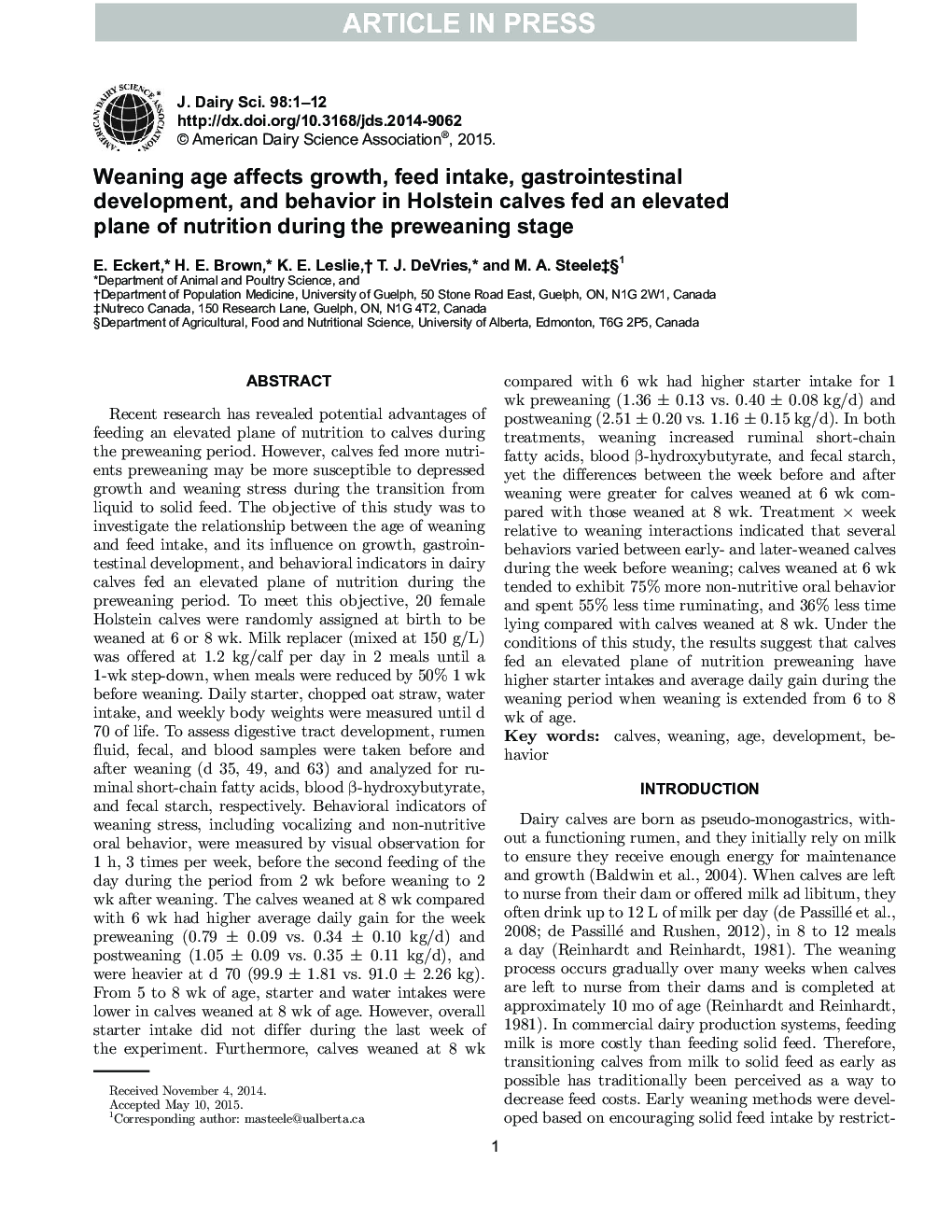| کد مقاله | کد نشریه | سال انتشار | مقاله انگلیسی | نسخه تمام متن |
|---|---|---|---|---|
| 10974342 | 1108024 | 2015 | 12 صفحه PDF | دانلود رایگان |
عنوان انگلیسی مقاله ISI
Weaning age affects growth, feed intake, gastrointestinal development, and behavior in Holstein calves fed an elevated plane of nutrition during the preweaning stage
ترجمه فارسی عنوان
سن عادت بر رشد، مصرف غذا، رشد گوارشی و رفتار در گوساله های هلشتاین تأثیر می گذارد که در طول مرحله قبل از بروز تغذیه افزایش می یابد
دانلود مقاله + سفارش ترجمه
دانلود مقاله ISI انگلیسی
رایگان برای ایرانیان
کلمات کلیدی
گوساله ها، شخم زدن، سن، توسعه، رفتار - اخلاق،
موضوعات مرتبط
علوم زیستی و بیوفناوری
علوم کشاورزی و بیولوژیک
علوم دامی و جانورشناسی
چکیده انگلیسی
Recent research has revealed potential advantages of feeding an elevated plane of nutrition to calves during the preweaning period. However, calves fed more nutrients preweaning may be more susceptible to depressed growth and weaning stress during the transition from liquid to solid feed. The objective of this study was to investigate the relationship between the age of weaning and feed intake, and its influence on growth, gastrointestinal development, and behavioral indicators in dairy calves fed an elevated plane of nutrition during the preweaning period. To meet this objective, 20 female Holstein calves were randomly assigned at birth to be weaned at 6 or 8 wk. Milk replacer (mixed at 150 g/L) was offered at 1.2 kg/calf per day in 2 meals until a 1-wk step-down, when meals were reduced by 50% 1 wk before weaning. Daily starter, chopped oat straw, water intake, and weekly body weights were measured until d 70 of life. To assess digestive tract development, rumen fluid, fecal, and blood samples were taken before and after weaning (d 35, 49, and 63) and analyzed for ruminal short-chain fatty acids, blood β-hydroxybutyrate, and fecal starch, respectively. Behavioral indicators of weaning stress, including vocalizing and non-nutritive oral behavior, were measured by visual observation for 1 h, 3 times per week, before the second feeding of the day during the period from 2 wk before weaning to 2 wk after weaning. The calves weaned at 8 wk compared with 6 wk had higher average daily gain for the week preweaning (0.79 ± 0.09 vs. 0.34 ± 0.10 kg/d) and postweaning (1.05 ± 0.09 vs. 0.35 ± 0.11 kg/d), and were heavier at d 70 (99.9 ± 1.81 vs. 91.0 ± 2.26 kg). From 5 to 8 wk of age, starter and water intakes were lower in calves weaned at 8 wk of age. However, overall starter intake did not differ during the last week of the experiment. Furthermore, calves weaned at 8 wk compared with 6 wk had higher starter intake for 1 wk preweaning (1.36 ± 0.13 vs. 0.40 ± 0.08 kg/d) and postweaning (2.51 ± 0.20 vs. 1.16 ± 0.15 kg/d). In both treatments, weaning increased ruminal short-chain fatty acids, blood β-hydroxybutyrate, and fecal starch, yet the differences between the week before and after weaning were greater for calves weaned at 6 wk compared with those weaned at 8 wk. Treatment à week relative to weaning interactions indicated that several behaviors varied between early- and later-weaned calves during the week before weaning; calves weaned at 6 wk tended to exhibit 75% more non-nutritive oral behavior and spent 55% less time ruminating, and 36% less time lying compared with calves weaned at 8 wk. Under the conditions of this study, the results suggest that calves fed an elevated plane of nutrition preweaning have higher starter intakes and average daily gain during the weaning period when weaning is extended from 6 to 8 wk of age.
ناشر
Database: Elsevier - ScienceDirect (ساینس دایرکت)
Journal: Journal of Dairy Science - Volume 98, Issue 9, September 2015, Pages 6315-6326
Journal: Journal of Dairy Science - Volume 98, Issue 9, September 2015, Pages 6315-6326
نویسندگان
E. Eckert, H.E. Brown, K.E. Leslie, T.J. DeVries, M.A. Steele,
